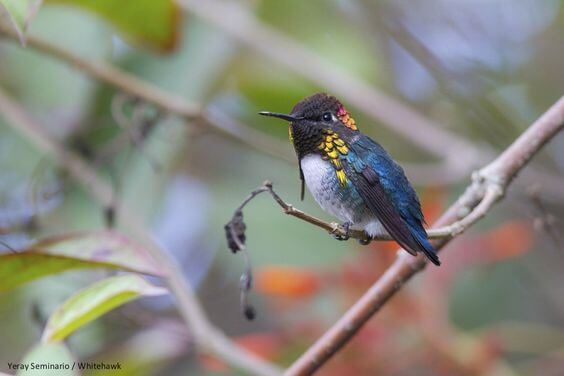Who would not love having hummingbirds around their house in the beautiful season of fall, right? People often try to attract hummingbirds with various things.
Feeders, flowers, and beautiful gardens- these are some of the things used to attract hummingbirds. However, there are some hummingbird facts that one should know before setting up the garden for hummingbirds.
These beautiful birds in pretty colors migrate through areas in fall and offer amazing visual delight throughout the season. Many people set up feeders for these roaming birds and wait for them to come over. However, you cannot attract any animal or bird without knowing everything about them.
If you wish to attract those pretty hummingbirds to your garden or lawn without getting confusing yourself on what to do, keep reading. Here are 20 hummingbird facts that no one ever talks about. These facts will surely help you understand the birds better. So, let us dig in and know these unique hummingbird facts.
1. They Cannot Smell
Yes! Hummingbirds do not have a sense of smell. This means that you cannot attract them with any smell of food or flowers. However, they do have great color vision. Most of the hummingbirds love flowers in red and orange shades. So, setting up red and orange flowers or having feeders in bright colors can work as a great idea while attracting the hummingbirds.
Although, some people also use color dyes in nectar to attract hummingbirds through color. However, dyes are a big no-no because they can be harmful for hummingbirds.
2. Heartbeat Rate

The heart of a hummingbird can beat up to 1260 beats per minute. If we talk about humans, a human heart beats only 60 to 100 beats per minute at rest. However, when these birds experience torpor (a state like hibernation) on a cold night, their hearts can beat as slow as 50 to 180 beats per minute.
3. Second Largest Family of Birds
There are over 330 known species of hummingbirds found in the Americas. Around 12 species visit the United States yearly but only 8 of them regularly breed in the country. Ruby-throated, Broad-Tailed, Rufous, Allen’s, Black-Chinned and Costa’s hummingbirds are some of the species commonly found in America.
The remaining species of hummingbirds are tropical species and so, they do not migrate regularly. These species can be found in the Caribbean, Central America, and South America.
4. They Have Weak Feet
This is one of those hummingbird facts that you can notice the next time they visit you. As compared to other birds, hummingbirds have extremely weak feet. This is the reason they use feet only for perching, preening and itching purposes.
As their feet are extremely weak, they cannot even walk or hop. These birds have evolved their feet smaller for lighter weight and eventually more efficient flying.
5. Their Lifespan
The average lifespan of a hummingbird varies from three years to twelve years. However, many experts believe their average life span to be only three to six years. This depends on various factors like the environmental conditions, predators, habitat conditions and the type of species.
The most lived known hummingbird till now is a female broad-tailed hummingbird. This bird was found in Colorado in 1976. She was found in the same place again in 1987. This made her around 12 years old and the oldest known hummingbird.
6. Their Memory
Research says that hummingbirds have a great memory. The birds remember every flower and every feeder they have ever been to. They also know the time it will take for a flower to be refilled with nectar.
Out of all the hummingbird facts, this is the most fascinating to know that the birds will remember visiting your garden and feeder. If they come across your area next year, they would visit you and your feeder. However, if your feeder is not at the same place, they may go out in search of other feeders and never come back.
7. Their Incredible Flapping Speed

The wings of a hummingbird can flap around 50 to 200 times per second. This depends on the purpose and direction of their flight and surrounding air conditions. The North American hummingbirds hold a record of around an average of 53 flaps per second in a normal flight.
The fastest record of 80 wing beats per second on an Amethyst wood star hummingbird. However, a giant hummingbird would be seen flapping its wings with a rate of only 10 to 15 flaps per second.
8. The Unique Tongue of Hummingbirds
This is also one of the hummingbird facts that can make you more interested in these tiny birds. They have ‘W’ shaped tongue, that is it is grooved like a ‘W’.
You may notice the tongue of some hummingbirds sticking out of their bills sometimes. If the bird is unable to retract it, it may be possible that the hummingbird has fed on a feeder that had honey and eventually fungal spores may have germinated on the tongue of the bird.
9. They Do Not Suck Nectar
It is common to assume that hummingbirds suck the nectar out of a flower when they visit it. Yes! They do intake nectar but not by sucking it through their long bills. They have tiny hairs on their tongue which help them lap up the nectar just like a cat. In simple words, they lick the nectar with their fringed and forked ‘W’ shaped tongues.
A capillary action occurs along their grunge which helps them get the nectar up to their throats and eventually swallow it. Also, they do not lick the nectar slowly. They lick around 10 to 15 times per second while feeding.
10. Their Flying Style
Hummingbirds are the only birds that can fly up, down, sideways, forwards, and even backward. The reason for this might be their body which is light weighted. Also, a hummingbird can fly at the maximum speed of around 30 miles per hour. Moreover, their maximum diving speed can be 50 to 60 miles per hour. These birds can adapt themselves for many unique types of flights.
11. The Smallest Eggs
The smallest eggs of a bird you will ever find are of hummingbirds. The egg of a hummingbird looks smaller even than a jellybean and a penny, measuring about half an inch long. However, the egg represents as much as 10 percent of the mother’s weight when it is laid.
12. Their Ability to Create Hybrid

One of the most surprising hummingbird facts you may get to know is that they can themselves create Hybrid with one another. Many species including the rofous, broad-tailed, calliope, costa’s, black-chinned and anna’s hummingbirds can breed together to create hybrid species.
This unique ability of the hummingbirds makes it difficult to identify them. It becomes very challenging to identify both the hybrid and the original species.
13. An Aggressive Species
The fact that they are small may let you assume that these birds would be peaceful and friendly. However, one of the surprising hummingbirds facts is that they are quite aggressive.
Despite their small size, they can be seen attacking bigger birds like crows, jays and other birds that come into their territory. It is said that hummingbirds always have one dominant hummingbird that guards all other feeder birds and chases away the intruders.
14. Their Feathers
Hummingbirds have only 1000 to 1500 features on their body. This is the least number of feathers of any bird species in the world. An obvious reason for this is their tiny bodies, the smaller the bird, the fewer feathers it will possess. Also, fewer feathers are a reason for their less weight and easy speedy flights.
15. Their Quick Digestion
All the hummingbirds have a great metabolism. The natural sucrose, a sugar found in the nectar of flowers is digested by the hummingbirds in just 20 minutes. Also, they have 97% efficiency for converting sugar into energy.
Some Other Interesting Hummingbird Facts
The hummingbird facts mentioned above are the facts you should know if you are a bird lover. However, there are a vast variety of hummingbirds found throughout the world and so are their facts.
Till now, you know only a few of their facts. But do not worry! We have got all the known possible facts for you. Keep reading and you will know some more interesting facts about these tiny birds.
- A hummingbird has the capability of breathing up to an average of 250 breaths per minute. This is their breathing speed when they are at rest. It would increase when they fly or do any other activity.
- As mentioned earlier, hummingbirds have a great metabolism. If the metabolism of a hummingbird would be given to an average human being, he would. must eat 285 pounds or almost 129 kgs of meat every single. day to maintain his weight.
- Every day, hummingbirds eat as much as half of their whole-body weight from flowers and insects to avoid starvation.
- Being only 5.7cm long, the bee hummingbird of Cuba holds the record for the smallest bird in the world.
- , Unlike other birds, hummingbirds do not mate for life. These birds do not even stay together to raise the babies.
- The hummingbirds are known to fly about their heads to alert humans to empty feeders or remove the sugar water if it has gone bad.
- As compared to other species of birds, the hummingbirds have their bills longer in proportion to their bodies. This is not a compulsion to be found in every hummingbird.
- Though hummingbirds cannot smell anything, they can see and hear better than a human body. These birds see in ultraviolet colors and can see much further than a human eye can.
All these facts are not the only hummingbird facts that you can find. As mentioned earlier, there are a lot of varieties in hummingbirds and different birds have different habits.
So, no matter how much you read about them, you will be able to know only once you step outside. It is time for you to fill and place your feeders out in the garden so that these tiny birds can visit you and you can notice them in detail.
Are These Facts Useful?
Well, getting to know some facts about the birds you love cannot be useless for sure. After knowing everything about hummingbirds, you probably now know how to attract them. Keeping these facts in mind will help you in deciding what to do and what not to do while attracting them toward your garden.
These facts will help you attract them quickly and efficiently without doing anything that harms the birds. So, why wait then? Start making attraction strategies for the hummingbirds with the help of these facts in no time and enjoy their delightful presence!


Thank you for the detailed information about Hummingbirds. I have been intrigued by them for as long as I can remember. I have two feeders, and several plants that attract them.